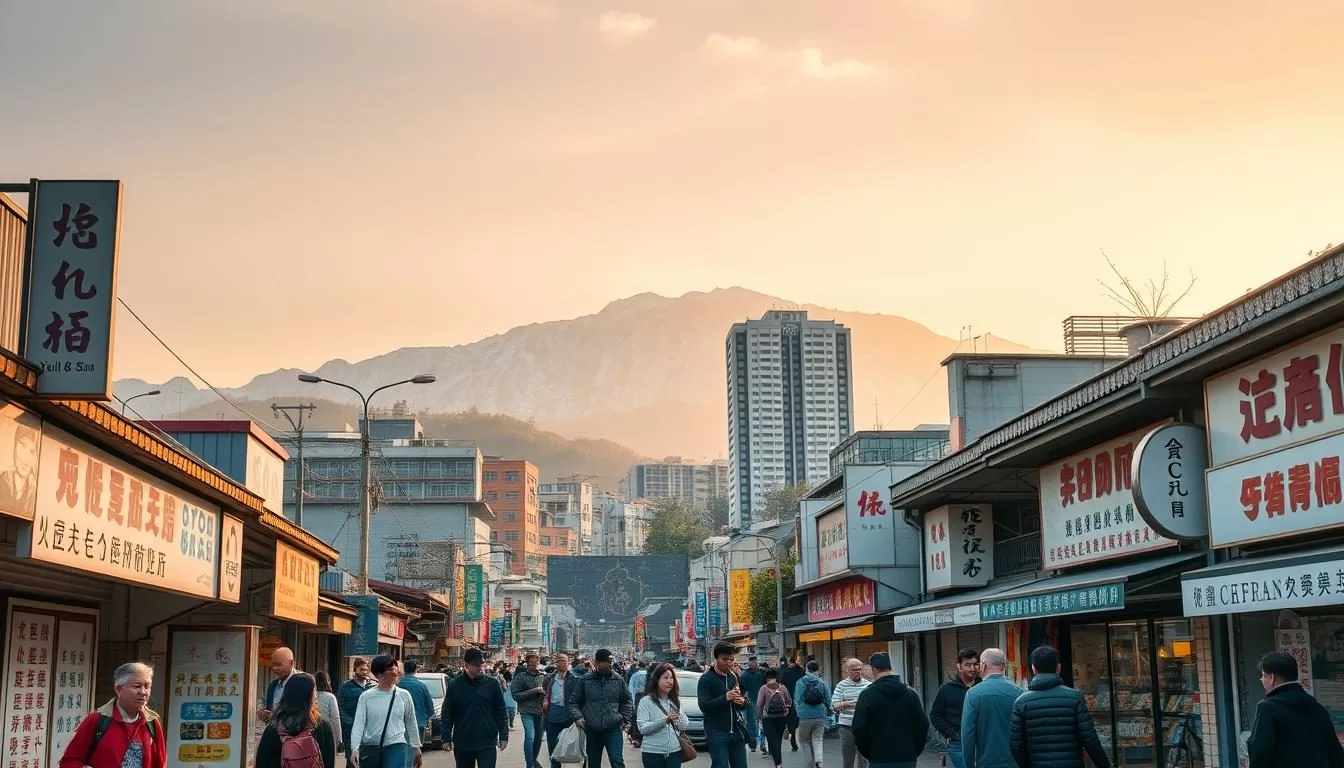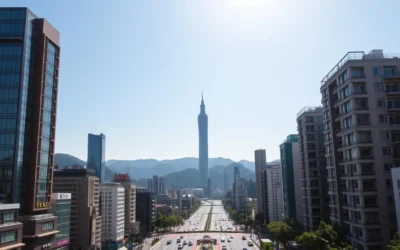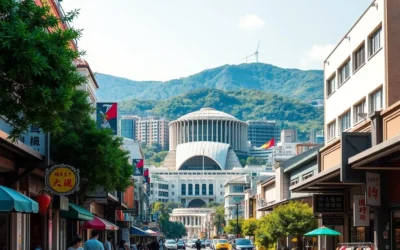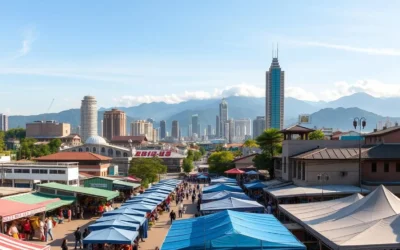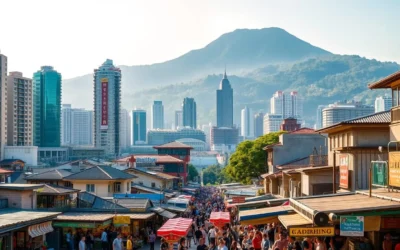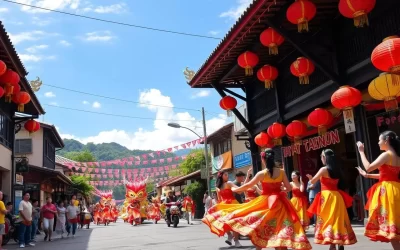As you explore the Republic of China, a relatively small island nation in East Asia, you’ll be immersed in a vibrant cultural landscape where multiple languages coexist.
With a population of over 23 million people, Taiwan is one of the most densely populated places in the world. The capital city, Taipei, is the heart of the country’s political, economic, and cultural activities.
Visiting Yunli County offers a unique opportunity to experience this linguistic diversity firsthand. Understanding the language situation will significantly enhance your travel experience, allowing you to appreciate the complex interplay between official policy and everyday language usage.
Taiwan’s Linguistic Landscape
Understanding Taiwan’s linguistic landscape requires a look into its historical context and current policies. You will find that the island’s language scene is a complex mix of influences from its past and present.
Historical Background of Languages in Taiwan
When Taiwan became a colony of Japan from 1895 to 1945, the Taiwanese language was discouraged, and Japanese became the official language of government and education. Later, in 1949, the KMT made Mandarin the official language, continuing the suppression of local languages like Taiwanese. The use of Taiwanese in public was banned, with punishments for violations. After Martial Law was lifted in 1987, Taiwanese began to experience a revival.

Current Language Policy in Taiwan
Today, Taiwan’s language policy has shifted towards inclusivity. The government now recognizes multiple languages, including Mandarin, Taiwanese Hokkien, Hakka, and indigenous languages, as national languages under the National Languages Development Act of 2019. You will notice that while Mandarin remains the primary language of instruction in schools, local languages are now taught in dedicated classes. Government services are primarily in Mandarin but are increasingly available in other recognized languages.
| Language | Status | Usage |
|---|---|---|
| Mandarin | Official Language | Primary language of government and education |
| Taiwanese Hokkien | National Language | Used in local communities and some government services |
| Hakka | National Language | Used in local communities and some cultural events |
| Indigenous Languages | National Languages | Used in indigenous communities and some cultural preservation efforts |
This shift represents Taiwan’s commitment to preserving its linguistic heritage while maintaining Mandarin as the common language for national unity and communication. As you explore Yunli County, you’ll experience this linguistic diversity firsthand.
Mandarin Chinese: The Official Language
As you explore Yunli County, Taiwan, you’ll discover that Mandarin Chinese plays a vital role as the official language. It’s the primary means of communication in government, education, and media, ensuring unity across the island. The widespread use of Mandarin Chinese facilitates communication among people from different regions, making it an essential part of Taiwan’s system of governance and daily life.

Taiwanese Mandarin vs. Standard Mandarin
Taiwanese Mandarin, or Guoyu, is the variant of Mandarin Chinese spoken in Taiwan. Although it’s distinct from the Mandarin spoken in mainland China, known as Putonghua, speakers of both variants can generally understand each other. The differences are akin to those between American and British English, with variations in vocabulary, pronunciation, and usage. Despite these differences, the core of the language remains the same, allowing for effective communication across the strait.
Written Chinese in Taiwan: Traditional Characters
One of the distinctive features of written Chinese in Taiwan is the use of traditional characters. Unlike mainland China, which adopted simplified characters in the 1950s, Taiwan has maintained the traditional system of writing. This choice preserves historical elements of Chinese writing and is seen as a way to maintain cultural heritage. You’ll notice traditional characters in signs, menus, and newspapers, which may require more strokes to write but are considered to better preserve the aesthetic and semantic richness of the language.
- You’ll immediately notice that Taiwan uses traditional Chinese characters in writing, unlike mainland China which adopted simplified characters.
- When reading signs, menus, or newspapers in Yunli County, you’ll encounter these complex traditional characters that preserve historical elements of Chinese writing.
- Mastering traditional characters requires memorizing more strokes, but many Taiwanese believe this system better preserves the language’s aesthetic and semantic richness.
The use of traditional characters is a significant aspect of Taiwan’s cultural identity, reflecting its commitment to preserving the heritage of the Chinese language in the modern world. As a result, when interacting with written Chinese in Taiwan, you’ll experience a deep cultural commitment to maintaining these traditional characters.
Taiwanese Hokkien: The Local Language
You’ll find that Taiwanese Hokkien is widely spoken in Yunli County, Taiwan, reflecting the area’s rich cultural heritage. As a local language, it plays a significant role in the daily lives of the people.
Origins and Development of Taiwanese Hokkien
Taiwanese Hokkien has its roots in the Hokkien dialect spoken in southern China. Over time, it has evolved and developed distinct characteristics in Taiwan, influenced by the local culture and history. The language has become an integral part of Taiwanese identity, with its own unique expressions and nuances. As you explore the local markets and interact with the older generation, you’ll notice the prevalence of Taiwanese Hokkien.
The historical context of Taiwanese Hokkien is closely tied to the migration of people from southern China to Taiwan. This migration brought the Hokkien dialect to the island, where it adapted and evolved. Today, Taiwanese Hokkien is an essential part of the linguistic landscape in Yunli County.
Current Usage and Prevalence in Daily Life
In Yunli County, Taiwanese Hokkien remains a dominant language in informal settings, such as markets, small businesses, and casual social interactions. 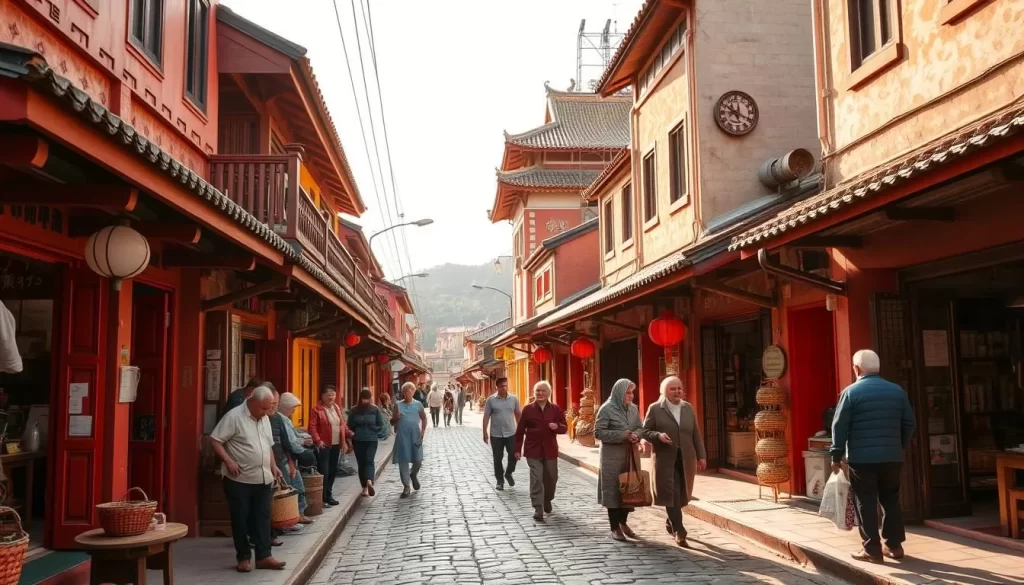 You’ll observe that many people, especially the older generation, use Taiwanese Hokkien as their primary means of communication. The language is also commonly used in rural areas and among the lower socio-economic classes.
You’ll observe that many people, especially the older generation, use Taiwanese Hokkien as their primary means of communication. The language is also commonly used in rural areas and among the lower socio-economic classes.
The use of Taiwanese Hokkien is context-dependent, with many people switching between Mandarin and Hokkien depending on the situation. For instance, in formal settings like schools and government institutions, Mandarin is more commonly used, while in casual conversations, Taiwanese Hokkien is preferred. This code-switching is a common phenomenon in Taiwan, reflecting the complex linguistic landscape of the country.
- In markets and night markets, Taiwanese Hokkien is the language of choice for vendors and customers alike, adding to the vibrant atmosphere.
- When interacting with older residents or in rural areas, you’re more likely to hear Taiwanese Hokkien being used.
- Many people in Yunli County seamlessly switch between Mandarin and Hokkien, depending on the social context or conversation topic.
Hakka: Preserving Cultural Heritage
As you explore Yunli County, Taiwan, you’ll discover the rich culture of the Hakka people, a significant aspect of the country’s diverse heritage.
The Hakka People and Their Language
The Hakka community, primarily residing in rural areas of Hsinchu, Miaoli, and Kaohsiung, is known for its strong working ethic and hearty cuisine. The Hakka language is an essential part of their identity, and efforts are being made to preserve it through various cultural initiatives. You can experience the Hakka language being spoken naturally at local festivals and in community gatherings.
The Hakka language is a vital component of Taiwan’s linguistic diversity, and understanding its significance can enrich your appreciation of the local language spoken in various contexts.
Where to Experience Hakka Culture and Language
Yunli County is an ideal place to immerse yourself in Hakka culture. Dedicated cultural parks and museums showcase traditional Hakka architecture, crafts, and linguistic heritage. You can also participate in Hakka festivals, sample traditional dishes in local restaurants, and interact with Hakka-speaking communities in rural villages.
| Activity | Location | Description |
|---|---|---|
| Cultural Parks Visit | Yunli County | Explore traditional Hakka architecture and crafts |
| Hakka Festivals | Various Locations | Experience vibrant cultural traditions and hear the Hakka language spoken |
| Traditional Cuisine | Local Restaurants | Sample hearty Hakka dishes and hear the language among staff and patrons |
Indigenous Formosan Languages in Yunli County, Taiwan: Official and Widely Spoken Languages
The Indigenous Formosan languages in Yunli County, Taiwan, offer a fascinating glimpse into the country’s original cultural identities. As you explore this region, you’ll encounter the rich linguistic diversity that is a hallmark of Taiwan’s Indigenous heritage.

The 16 Recognized Indigenous Groups
Taiwan is home to 16 recognized Indigenous groups, each with its own distinct language and cultural practices. These groups are a vital part of Taiwan’s identity, and their languages are a key component of their cultural heritage. The diversity of these languages is a significant aspect of the country’s linguistic landscape, with many being considered endangered.
Of the 26 languages collectively known as the Formosan Languages, 10 are extinct, and 5 are moribund. This highlights the urgent need for preservation efforts to protect these languages and the cultures they represent.
Preservation Efforts and Cultural Significance
The government and local communities are working together to preserve Indigenous languages through various initiatives. You’ll witness government-sponsored programs aimed at promoting these languages, including educational programs, cultural festivals, and media productions. When visiting cultural centers, you can participate in language workshops that introduce you to basic phrases in local Indigenous languages.
These preservation efforts are crucial not only for maintaining the languages themselves but also for preserving the traditional knowledge, ecological wisdom, and spiritual practices tied to Indigenous identities. As you learn about the critical state of many Indigenous languages, you’ll appreciate the cultural significance of these efforts. The increasing visibility of Indigenous languages in public spaces, from museum exhibits to bilingual signage, reflects Taiwan’s commitment to honoring its original inhabitants.
By engaging with these languages and cultures, you’ll gain a deeper understanding of Taiwan’s rich heritage and the importance of preserving it for future generations.
Japanese Influence on Taiwan’s Language
As you explore Taiwan, you’ll notice the enduring presence of Japanese in its linguistic tapestry. The island’s history with Japan has left a lasting legacy that is evident in various aspects of Taiwanese life.
Colonial Legacy in Linguistic Terms
The period of Japanese colonial rule had a profound impact on Taiwan’s language landscape. Many older Taiwanese still speak Japanese, and the language’s influence can be seen in various linguistic elements. Japanese also persists as an “elite” language for Taiwan’s business leaders, many of whom studied Japanese and visited Japan while in school. This historical connection has contributed to the continued relevance of Japanese in Taiwan’s business sector.
Japanese Language Usage Today
Today, Japanese remains a popular foreign language choice in Yunli County’s educational institutions, with many students studying it for business opportunities and cultural interests. When shopping in department stores or visiting tourist attractions, you might notice Japanese-speaking staff catering to the significant number of Japanese tourists who visit Taiwan annually. The value of Japanese language skills is particularly evident in Taiwan’s business sector, especially in companies maintaining strong trade relationships with Japan. Moreover, the popularity of Japanese pop culture has further reinforced interest in the language among younger generations.
You’ll also see evidence of Japanese linguistic influence in public transportation announcements, which often include Japanese alongside other languages to accommodate international visitors. This accommodation reflects the importance of Japanese tourism for Taiwan’s economy and highlights the ongoing relevance of the Japanese language in Taiwan today.
English and Other Foreign Languages
As you explore Yunli County, Taiwan, you’ll notice the growing importance of English and other foreign languages in the region. While Mandarin Chinese is the official language of Taiwan, English is becoming increasingly significant in various aspects of life, including education, government services, and public signage.
English Proficiency Across Taiwan
English is not presently one of the national languages of Taiwan, but the government has set a goal to make Taiwan “fully bilingual” by 2030. This initiative aims to significantly enhance English proficiency across the island to boost international competitiveness. You may observe the implementation of this policy in schools, where English-language instruction and bilingual education programs are becoming more prevalent.
- Increased English-language instruction in schools
- Bilingual education programs to enhance English proficiency
- More English-language options in government services and public signage
Bilingual2030 Policy and Its Impact
The Bilingual2030 policy has far-reaching implications beyond education. You’ll notice its impact on public signage, transportation announcements, and government websites, all of which are increasingly offering English translations. While some people worry about the potential impact on local language usage, others see the economic and diplomatic benefits of widespread English proficiency. The policy has sparked debates about language preservation and cultural identity, reflecting the complexities of Taiwan’s linguistic landscape.
As you interact with government services and public facilities, you’ll see the gradual implementation of this policy, with more English-language options becoming available. This shift is part of Taiwan’s efforts to enhance its international competitiveness and communication with the global community.
Practical Language Tips for Your Taiwan Journey
To fully immerse yourself in Taiwan’s vibrant culture, it’s essential to grasp the languages spoken across the island. For casual visitors or those planning to spend time in Taiwan, picking upMandarinis highly recommended. While many can get by with Mandarin, there’s a significant portion of the population, especially among the younger generation or those who migrated from China in the last 80 years, who speak little to no Taiwanese.
Learning a few basic Mandarin phrases will significantly enhance your experience, opening doors to more authentic interactions with locals. When visiting traditional markets or rural areas, attempting simple greetings in Taiwanese Hokkien will delight older residents and show respect for local culture.
Your smartphone can be a valuable language tool; consider downloading translation apps that work offline and include Traditional Chinese character recognition. The language situation varies by context: government offices and formal businesses primarily use Mandarin, while local markets and family-run establishments might favor Taiwanese Hokkien.
When dining out, learning food-related vocabulary in Mandarin will be beneficial, as menus in smaller establishments may not include English translations. In business settings, language choice can carry social implications—Mandarin is used for formal negotiations, while switching to Taiwanese might signal a more personal relationship.
The public transportation system offers announcements in multiple languages, making navigation relatively easy. Guided tours at tourist attractions are often available in several languages, including English, Japanese, and Korean. When shopping in local markets, basic number knowledge and hand gestures can effectively supplement limited language skills.
By making an effort to communicate, even imperfectly, you’ll be met with patience and appreciation throughout the island. Taiwanese people value visitors who show interest in their language and culture, making your journey even more rewarding.
The above is subject to change.
Check back often to TRAVEL.COM for the latest travel tips and deals.
